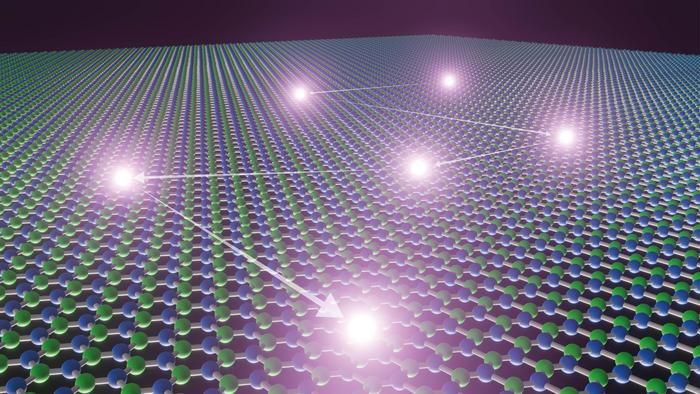A discovery in the field of nanofluidics could shake up our understanding of molecular behavior on the tiniest scales. Research teams at EPFL and the University of Manchester have revealed a previously hidden world by using the newly found fluorescent properties of a graphene-like 2D material, boron nitride. This innovative approach enables scientists to track individual molecules within nanofluidic structures, illuminating their behavior in ways never before possible. The study’s findings are published in the journal Nature Materials.

Credit: Titouan Veuillet / EPFL
A discovery in the field of nanofluidics could shake up our understanding of molecular behavior on the tiniest scales. Research teams at EPFL and the University of Manchester have revealed a previously hidden world by using the newly found fluorescent properties of a graphene-like 2D material, boron nitride. This innovative approach enables scientists to track individual molecules within nanofluidic structures, illuminating their behavior in ways never before possible. The study’s findings are published in the journal Nature Materials.
Nanofluidics, the study of fluids confined within ultra-small spaces, offers insights into the behavior of liquids on a nanometer scale. However, exploring the movement of individual molecules in such confined environments has been challenging due to the limitations of conventional microscopy techniques. This obstacle prevented real-time sensing and imaging, leaving significant gaps in our knowledge of molecular properties in confinement.
Thanks to an unexpected property of boron nitride, EPFL’s researchers have achieved what was once thought impossible. This 2D material possesses a remarkable ability to emit light when in contact with liquids. By leveraging this property, scientists at EPFL’s Laboratory of Nanoscale Biology have succeeded in directly observing and tracing the paths of individual molecules within nanofluidic structures. This revelation opens the door to a deeper understanding of the behaviors of ions and molecules in conditions that mimic biological systems.
Professor Aleksandra Radenovic, Head of LBEN, explains, “Advancements in fabrication and material science have empowered us to control fluidic and ionic transport on the nanoscale. Yet, our understanding of nanofluidic systems remained limited, as conventional light microscopy couldn’t penetrate structures below the diffraction limit. Our research now shines a light on nanofluidics, offering insights into a realm that was largely uncharted until now.”
This newfound understanding of molecular properties has exciting applications, including the potential to directly image emerging nanofluidic systems, where liquids exhibit unconventional behaviors under pressure or voltage stimuli. The research’s core lies in the fluorescence originating from single-photon emitters at the hexagonal boron nitride’s surface. “This fluorescence activation came unexpectedly, as neither hBN nor the liquid exhibit visible-range fluorescence on their own. It most likely arises from molecules interacting with surface defects on the crystal, but we are still not certain of the exact mechanism,” says doctoral student Nathan Ronceray, from LBEN.
Surface defects can be missing atoms in the crystalline structure, whose properties differ from the original material, granting them the ability to emit light when they interact with certain molecules. The researchers further observed that when a defect turns off, one of its neighbors lights up, because the molecule bound to the first site hopped to the second. Step by step, this enables reconstructing entire molecular trajectories.
Using a combination of microscopy techniques, the team monitored color changes and demonstrated that these light emitters release photons one at a time, offering pinpoint information about their immediate surroundings within around one nanometer. This breakthrough enables the use of these emitters as nanoscale probes, shedding light on the arrangement of molecules within confined nanometer spaces.
Professor Radha Boya’s group at the department of Physics in Manchester crafted the nanochannels from two-dimensional materials, confining liquids at mere nanometers from the hBN surface. This partnership allowed for optical probing of these systems, uncovering hints of liquid ordering induced by confinement. “Seeing is believing, but it is not easy to see confinement effects at this scale. We make these extremely thin slit-like channels, and the current study shows an elegant way to visualize them by super-resolution microscopy,” Radha Boya says.
The potential for this discovery is far-reaching. Nathan Ronceray envisions applications beyond passive sensing. “We have primarily been watching the behavior of molecules with hBN without actively interacting with, but we think it could be used to visualize nanoscale flows caused by pressure or electric fields.” This could lead to more dynamic applications in the future for optical imaging and sensing, providing unprecedented insights into the intricate behaviors of molecules within these confined spaces.
Journal
Nature Materials
DOI
10.1038/s41563-023-01658-2
Article Title
Liquid-activated quantum emission from pristine hexagonal boron nitride for nanofluidic sensing
Article Publication Date
31-Aug-2023




